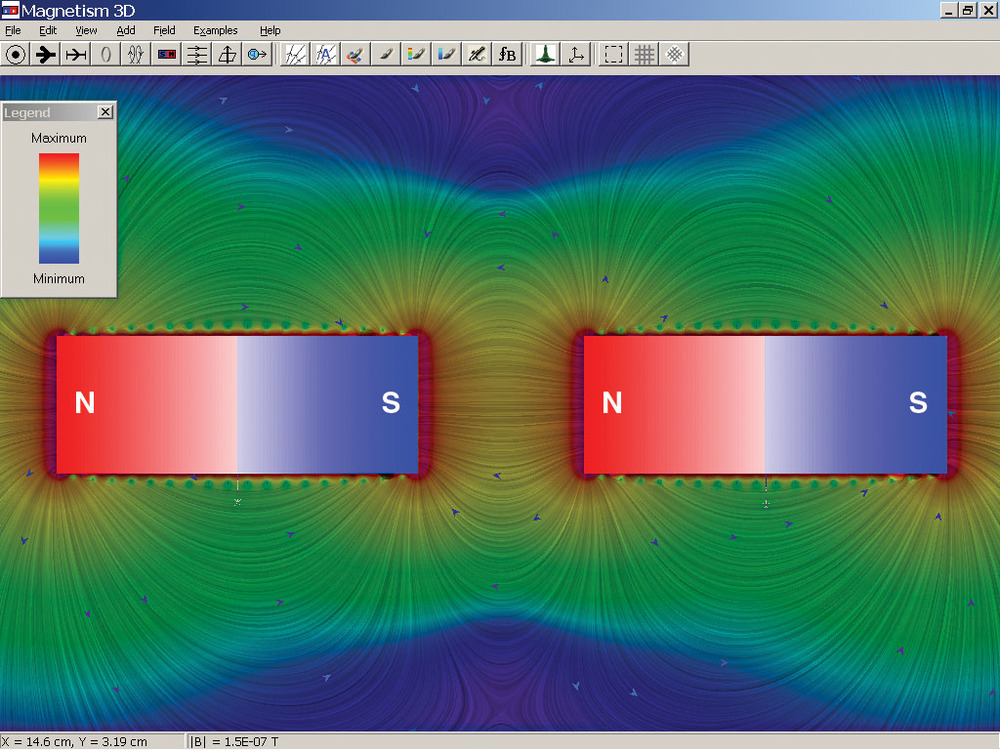Application
openEMS is a free and open electromagnetic field solver using the FDTD method that supports cartesian and cylindrical coordinates. Matlab or Octave are used as an easy and flexible scripting interface.

Contributors
Magnetic Field of a Bar Magnet. DongJoon 2018-01-05 Magnetism Simulation. Magnetic field around magnet The space where the magnetic force of the magnet acts is called a ‘magnetic field.’ The direction of the magnetic field is determined in the direction indicated by Read more. Similar to Electrostatics 3D, Magnetism 3D is an interactive software program that allows students to study magnetic fields using a variety of stunning visualization methods. Magnetism 3D utilizes colorful two-dimensional and three-dimensional graphics to display magnetic field lines for current-carrying straight wires, current-carrying wire. Maxwell is an industry-leading electromagnetic field simulation software for the design and analysis of electric motors, actuators, sensors, transformers and other electromagnetic and electromechanical devices. Low-frequency EM simulation. Automatic, adaptive meshing. Multidomain system modeling. Expert design interfaces. Magnetic Field Simulation Software Free Online Magnetic Field Modeling Software Software for this is relatively hard to come. 3-D Magnetostatic Field Simulation (Falstad) is the most readily available 'free' solution but it's not all that - it's written in Java and a bit idiosyncratic.
EMS is a magnet and electromagnetic software and simulation tool that computes 3D magnetic and electric field and flux, electric potential, voltage, current, magnetic force, electric force, torque, eddy current and losses, skin effect, proximity effect, and electromagnetic induction. EMS offers the state-of-the-art accuracy and power of the.
Thorsten Liebig1, Andreas Rennings1, Sebastian Held1, Daniel Erni1
Contact
Free
Progress
Resources
OpenEMS is a free and open source FDTD solver written in C++. OpenEMS supports cylindrical coordinates and is specifically developed for MRI applications. An extensive Matlab (or Octave) interface is used to define the FDTD options. The geometry used for the FDTD simulations is handled by the CSXCAD library which is part of the openEMS project.
Features:
- Efficient EC-FDTD method in full 3D cartesian coordinates (x,y,z)
- Efficient EC-FDTD method in full 3D cylindrical coordinates (ρ,φ, z)
- Supports virtual family voxel models
- Fully graded mesh
- Multi-threading, SIMD (SSE) and MPI support for high speed parallel FDTD
- Simple engine extensions API to easily introduce new features to the FDTD algorithm
- Absorbing boundary conditions (MUR, PML)
- Coordinate dependent material definitions
- Coordinate dependent excitation definitions (e.g. mode-profiles)
- Dispersive material (Drude/Lorentz/Debye type)
- Field dumps in time and frequency domain as vtk or hdf5 file format
- Flexible post-processing routines (mostly in Matlab)
- Subgrids to reduce simulation time in cylindrical coordinates
- Remote simulations using SSH (Linux only)
Publications
Affiliations
1General and Theoretical Electrical Engineering (ATE), Faculty of Engineering, University of Duisburg-Essen and GENIDE – Center for Nanointegration Duisburg-Essen, Duisburg, Germany
Figures
Please Share
Discuss this Project
Do you want to join our discussions and get news and updates about the projects? Talk to us over Slack!
Submit a Project
Do you work on an open source project with potential application for MRI or other related medical research and technology? We will also highlight early stage projects (prior to a stable release and documentation) in order to improve collaboration at that early stage.
Overview

Here you can find an overview of open source hard- and software projects, current progress, contact persons and links to the development and documentation websites. We just started, more projects will be uploaded very soon.
Integrated Engineering Software recently announced a major update to version 9.3 of its AMPERES 3D magnetic field solver for simulating and optimizing electromagnetic components. Highlights of the new release cited by the company include an enhanced coils and winding editor, more physics manipulation capabilities and various improvements that enhance overall performance.
Integrated describes AMPERES as a fully functional CAE package that comes as a complete and ready-to-use solution. The software deploys with both FEM (finite element method) and BEM (boundary element method) solvers. It can automatically choose which solver to use for a design under study or designers and engineers can specify either solver for their particular application needs.
AMPERES includes parametric analysis optimization tools for what-if analyses as well API (application programming interface) and scripting capabilities for advanced optimization. The software supports 64-bit parallel processing and unattended batch solving of multiple files.
Standard features include static and phasor analysis modes; the ability to simulate non-linear ferromagnetic, permanent magnet and lossy magnetic materials; force, torque, flux linkage and inductance calculations; and an array of display forms for plotting scalar and vector field quantities including graphs, contour plots and arrow plots. Additional features include CAD healing utilities, an intuitive and structured interface and several built-in, user-extensible materials tables and libraries.
AMPERES works with geometry from major mainstream CAD systems from such developers as Autodesk, PTC, Siemens and SOLIDWORKS. It also supports import of such file formats as SAT, STEP, 3DM, IGES and DXF. Through its API capabilities, applications such as Excel, MATLAB and Microsoft Visual Studio can work with AMPERES in an interconnected environment.
The Coils and Winding Editor can help users configure types of coils, create coils by assigning those types to geometry as well as create windings by specifying combinations of coils and circuitry. The Winding Editor enables users to select coils then configure their connection according to winding type. Users can also configure a source, configure the impedance and configure external load connections.
The AMPERES Coils and Winding Editor can now work with 2D/RS (rotationally symmetric) and full 3D models. With the latest update, users can generate irregular six-sided volumes to carry current. The company adds that it has improved the volume current density formulation, which, it says, leads to more accurate results on any irregular shaped volume.
One of the general performance enhancements introduced in the AMPERES 9.3 update is faster loading of large geometry models. By way of example, the company says that users of the latest update to AMPERES should see a reduced the loading time for a model with 50,000 volumes/surfaces from 5 minutes to about 1 minute.
3d Magnetic Field Simulation Software Downloads
AMPERES 9.3 offers more functions for geometry generation and operation such as creating 2D plot objects, 2D contour plots and screen coordinates. A few of the new functions for field inquiries are field quantities at specified points, floating voltage on conductors and current through a surface. Added physics manipulation capabilities include floating conductors, boundary conditions and total surface current. More functions to manage material properties, such as the magnet remanence and coercivity, have been incorporated into this release.
The AMPERES 9.3 update also sees several enhancements in its finite element solver for transient nonlinear models. Improvements to its iterative matrix solver provide more consistent convergence for complex problems with a large number of constraint equations, says the company. Integrated Engineering adds that the software’s BEM techniques now deliver more stable simulation results for models consisting of a combination of surface elements and line elements.
3d Magnetic Field Simulation Software Free
For more information on version 9.3 of the AMPERES 3D magnetic field solver, click here.
3d Magnetic Field Simulation Software Free
Sources: Press materials received from the company and additional information gleaned from the company’s website.